Photo Essay: Education For Children In DR Congo
Photo essay on children living in the Democratic Republic of Congo to mark the launch of Save the Children's first global campaign: education for children in armed conflict zones.
Photographer: Marcus Bleasdale. Photos copyright of Save the Children and Marcus Bleasdale.
The campaign – and new name for it – will be launched in New Zealand by the Prime Minister at Parliament on the 13th September 4pm.

Providing education for children affected by armed conflict
Over two years since the official end of the war in the Democratic Republic of Congo (DRC), an estimated 30,000 people continue to perish every month in conflict-related deaths. Over 4 million people have been displaced.
The physical abuse of civilians by the military continues largely unpunished, and children remain at high risk of use by armed groups, family separation and rape.
"We were tired of their attacks and the war," says Sifa, 15. "Children were dead. Parents were dead. There was no school. Everything was bad and in chaos. Instead of waiting to be exterminated, we thought it best to become active combatants. I was there for three years. My 'husband' was the first man I knew. I was eleven or twelve years old."
Award winning photographer, Marcus Bleasdale has been in the DRC for Save the Children photographing the effect of years of conflict on children like Sifa's lives, whether they have been forced to fight, have been displaced by conflict, sexually exploited or used as unpaid labour.
More than 50 million children around the world are affected by armed conflict. Education could turn their lives around but helping them is seen as the hardest challenge.
Save the Children is working to rebuild schools and the finance system to support education in the DRC. Schools provide children with a safe place to be, equips them with the skills to look after themselves and provides them with better prospects for their future.
Marcus Bleasdale
captions
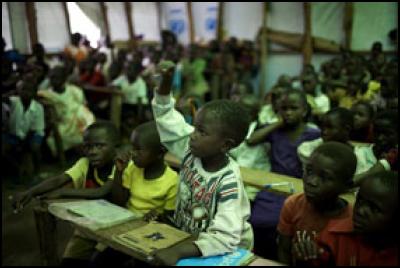
School for Internally Displaced People (IDP) set up by UNICEF with 604 pupils. At night the classrooms are used for new IDP's who are fleeing from the fighting in and around Gety. About 2000 now staying in the classrooms.
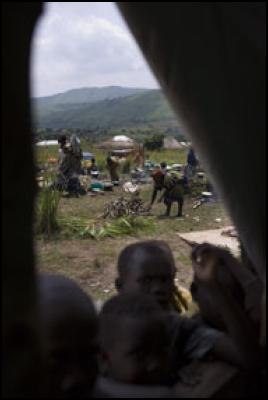
New arrivals and new children are not registered for school yet and hang out outside the classrooms during the day trying to pick up information and learn.
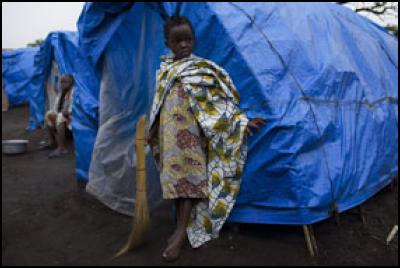
Imani Neema (7) sweeping in Tchomia Camp.
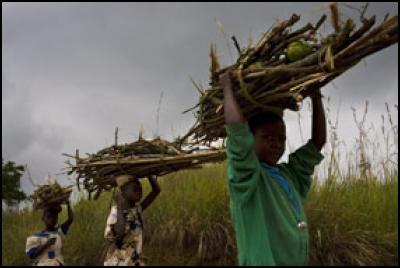
Girls from Kotoni Displaced camp collect firewood to sell in the camp in order to pay for their school fees. Mbunia Ajiva 10 years, Ngave Bazungai 9 years, and Ali Muchuna, 7 years.
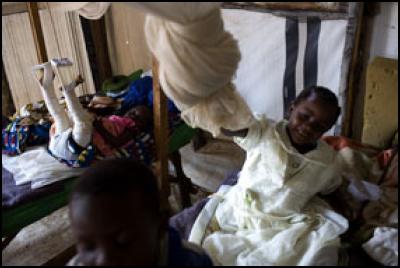
Francise Buswara (7) and her brother Dany Rupiny (5). In the mobile hospital in Bunia. Francise had a leg infection when they fled from Bunia in 2003 and stayed in the bush with their grandmother. The wound became sceptic and one leg was removed. She goes to school in the hospital where teaching is provided onsite. She has learnt her vowels AEIOU and she is learning French. Their mother is in the mining town of Watsa with a new husband and so they are being taken care of by their grandmother.
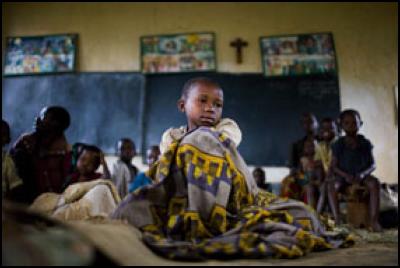
Mapenzi Ngave (10) from Kakado fled the fighting and now she is taking refuge in Gety School in the Catholic mission. She has never been to school as there is no money to pay the fees. Her mother has 9 children and it is impossible to pay for fees and food at the same time.
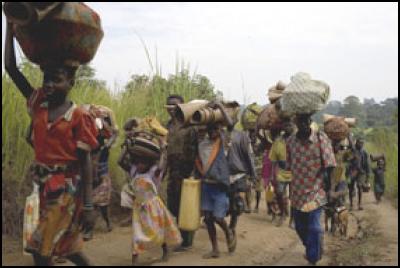
Children flee the fighting in Bavi, Ituri and travel the 40km to Gety through the forests. They bring what they can and they try to bring their school books if they have time to pack them. There will be no hope of an education for the 19,000 children who fled into Gety in the month of July 2006 for many months as the security situation will not allow it.

Soldiers stand by as children flee the fighting in Bavi and Ituri to travel to Gety.
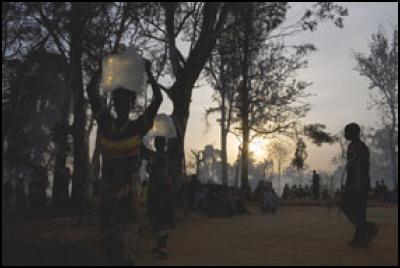
Mapuzi (12) and her mother collect water outside the displaced camp in Gety. With her father dead her mother has no money to send her to school. She used to get sad when she saw the other children in the village go to school, but now no one can go because of the war.
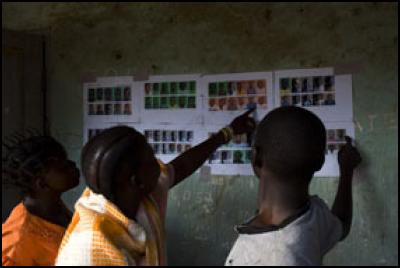
Locals look at the Save the Children posters distributed to find families who were lost in the vast movement of people fleeing the fighting.
ENDS


 Gordon Campbell: On Why We Can’t Survive Two More Years Of This
Gordon Campbell: On Why We Can’t Survive Two More Years Of This Peace Action Ōtautahi: Bridge Of Remembrance Peace Protest
Peace Action Ōtautahi: Bridge Of Remembrance Peace Protest National Wetland Trust: Public Asked To Help Prevent Fires In Wetlands This Summer
National Wetland Trust: Public Asked To Help Prevent Fires In Wetlands This Summer Lillian Hanly, RNZ: The Year In Politics - Stories That Dominated The Headlines In 2024
Lillian Hanly, RNZ: The Year In Politics - Stories That Dominated The Headlines In 2024 Waikato Regional Council: Studies Open Door To Mercury Islands Underwater World
Waikato Regional Council: Studies Open Door To Mercury Islands Underwater World Office of the Privacy Commissioner: Christmas Is About Giving, But Don’t Give Up Your Privacy
Office of the Privacy Commissioner: Christmas Is About Giving, But Don’t Give Up Your Privacy The Rail Advocacy Collective: Chris Trotter - Running Us Off The Rails
The Rail Advocacy Collective: Chris Trotter - Running Us Off The Rails


